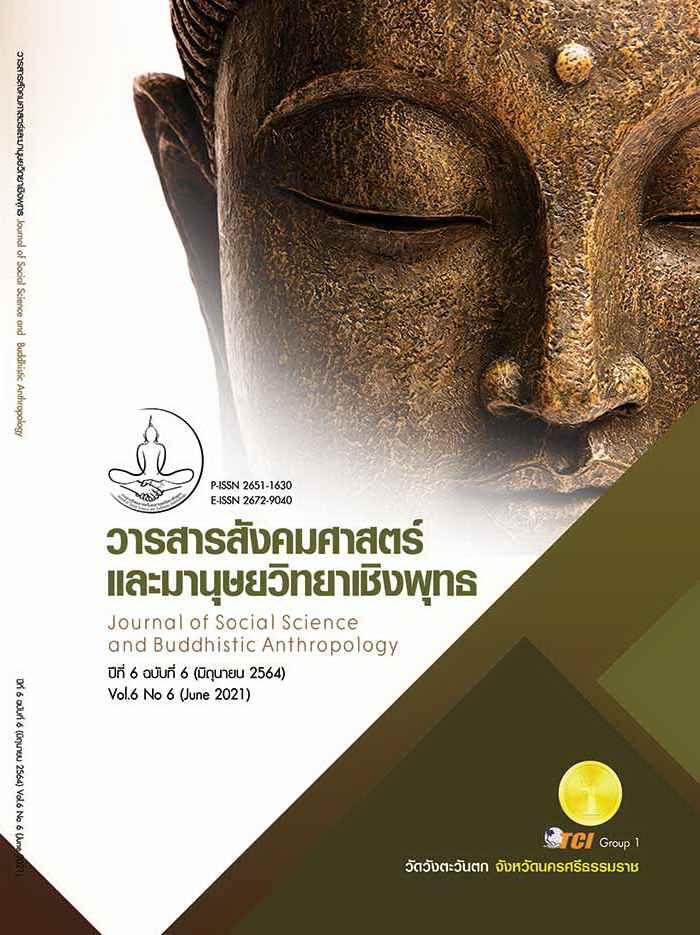CHARACTERISTICS OF PSYCHOLOGICAL PROTECTION SKILLS TO GAME ADDICTION AMONG ADOLESCENTS
Keywords:
Adolescence, Game Addiction, Psychological Immunity Intervention, Protection SkillsAbstract
The Objectives of this research article were to study the characteristics of psychological protection skills to game addiction among adolescents. The researcher study quantitative information using in - depth interviews and questionnaires with 15 keys informants selected through purposive sampling. The data were collected from five psychiatrists and psychologists, who have more than 5 years of experience in treating and protecting game addiction behaviors or publish at least 3 related academic articles, five adolescents who have high psychological protection skills toward game addiction behaviors with Game - P score ≥ 65 and Game Addiction Screening Test - score 24, and five adolescents who have low psychological protection skills toward game addiction behaviors with Game - P score ≤ 64 and Game Addiction Screening Test - score ≥ 33. The interview uses psychological protection skills to game addiction as a framework before leading to content analysis.The research findings indicate that there are four components of the psychological protection skills to game addiction in adolescents which are self - esteem, self - control, coping strategies, and the understanding of game addiction impact. Participants such as teachers, psychiatrists, psychologists, and academicians can utilize this research to treat and protect game addiction behaviors among adolescents and related groups.
References
กรมสุขภาพจิต. (2556). รายงานประจำปีกรมสุขภาพจิตประจำปี 2556. กรุงเทพมหานคร: บางกอกบล็อก.
_________. (2560). รายงานประจำปีกรมสุขภาพจิตประจำปี 2560. กรุงเทพมหานคร: ละม่อน.
ชาญวิทย์ พรนภดล และคณะ. (2557). การพัฒนาแบบทดสอบการติดเกม. วารสารสมาคมจิตแพทย์แห่งประเทศไทย, 59(1), 3-14.
__________. (2559). แนวทางการบำบัดรักษาภาวะติดอินเทอร์เน็ตและเกม. กรุงเทพมหานคร: มีเดียโซน พริ้นติ้ง.
__________. (2560). การพัฒนาแบบวัดภูมิคุ้มกันการติดเกม. วารสารสมาคมจิตแพทย์แห่งประเทศไทย, 62(1), 3-16.
ณัฐนันท์ ศิริเจริญ. (2558). รูปแบบการสื่อสารเพื่อการรู้เท่าทันสื่อและสารสนเทศจากสื่ออินเทอร์เน็ตของเยาวชนไทย. ศรีปทุมปริทัศน์ ฉบับมนุษยศาสตร์และสังคมศาสตร์, 15(1), 46-57.
ผู้ทรงคุณวุฒิ 1. (18 ธันวาคม 2562). คุณลักษณะภูมิคุ้มกันทางจิตในการป้องกันการติดเกมในวัยรุ่น. (กัณฐรัตน์ เหลืองอ่อน, ผู้สัมภาษณ์)
ผู้ทรงคุณวุฒิ 2. (18 ธันวาคม 2562). คุณลักษณะภูมิคุ้มกันทางจิตในการป้องกันการติดเกมในวัยรุ่น. (กัณฐรัตน์ เหลืองอ่อน, ผู้สัมภาษณ์)
ผู้ทรงคุณวุฒิ 3. (18 ธันวาคม 2562). คุณลักษณะภูมิคุ้มกันทางจิตในการป้องกันการติดเกมในวัยรุ่น. (กัณฐรัตน์ เหลืองอ่อน, ผู้สัมภาษณ์)
ผู้ทรงคุณวุฒิ 5. (18 ธันวาคม 2562). คุณลักษณะภูมิคุ้มกันทางจิตในการป้องกันการติดเกมในวัยรุ่น. (กัณฐรัตน์ เหลืองอ่อน, ผู้สัมภาษณ์)
ผู้ให้ข้อมูล 6. (18 ธันวาคม 2562). คุณลักษณะภูมิคุ้มกันทางจิตในการป้องกันการติดเกมในวัยรุ่น. (กัณฐรัตน์ เหลืองอ่อน, ผู้สัมภาษณ์)
วรุณา กลกิจโกวินท์ และคณะ. (2558). การติดเกมคอมพิวเตอร์ ปัจจัยเสี่ยงและปัจจัยป้องกันของเด็กนักเรียนในเขตดุสิต กรุงเทพมหานคร. วชิรเวชสาร, 59(3), 1-14.
วัยรุ่น 2. (18 ธันวาคม 2562). คุณลักษณะภูมิคุ้มกันทางจิตในการป้องกันการติดเกมในวัยรุ่น. (กัณฐรัตน์ เหลืองอ่อน, ผู้สัมภาษณ์)
วัยรุ่น 5. (18 ธันวาคม 2562). คุณลักษณะภูมิคุ้มกันทางจิตในการป้องกันการติดเกมในวัยรุ่น. (กัณฐรัตน์ เหลืองอ่อน, ผู้สัมภาษณ์)
วัยรุ่น 7. (18 ธันวาคม 2562). คุณลักษณะภูมิคุ้มกันทางจิตในการป้องกันการติดเกมในวัยรุ่น. (กัณฐรัตน์ เหลืองอ่อน, ผู้สัมภาษณ์)
วัยรุ่น 8. (18 ธันวาคม 2562). คุณลักษณะภูมิคุ้มกันทางจิตในการป้องกันการติดเกมในวัยรุ่น. (กัณฐรัตน์ เหลืองอ่อน, ผู้สัมภาษณ์)
วัยรุ่น 9. (18 ธันวาคม 2562). คุณลักษณะภูมิคุ้มกันทางจิตในการป้องกันการติดเกมในวัยรุ่น. (กัณฐรัตน์ เหลืองอ่อน, ผู้สัมภาษณ์)
สำนักงานกองทุนสนับสนุนการส่งเสริมสุขภาพ. (2561). WHO ระบุการติดเกมส์เป็นปัญหาสุขภาพจิต. เรียกใช้เมื่อ 3 สิงหาคม 2563 จาก https://www.thaihealth.or. th/Content/
สำนักงานพัฒนาธุรกรรมทางอิเล็กทรอนิกส์ องค์การมหาชน. (2556). รายงานผลการสำรวจพฤติกรรมผู้ใช้อินเทอร์เน็ตในประเทศไทย ปี 2556. เรียกใช้เมื่อ 5 สิงหาคม 2563 จาก https://www.etda .or.th/download-publishing/10/
__________. (2561). ETDA เปิดพฤติกรรมผู้ใช้อินเทอร์เน็ตปี 61 คนไทยใช้เน็ตเพิ่ม 10 ชั่วโมง 5 นาทีต่อวัน. เรียกใช้เมื่อ 18 สิงหาคม 2563 จาก https://www.etda.or.th content/etda-reveals-thailand-internet-user-profile-2018.html
สุภาวดี เจริญวานิช. (2557). พฤติกรรมการติดเกม : ผลกระทบและการป้องกัน. วารสารวิทยาศาสตร์และเทคโนโลยี, 22(6), 871-879.
อุมาพร ดุมกระโทก และธัญญรัศม์ ชิดไธสง. (2562). ความสัมพันธ์ระหว่างภูมิคุ้มกันทางจิตกับพฤติกรรมเสี่ยงของนักเรียนระดับมัธยมศึกษาตอนต้น. วารสารศึกษาศาสตร์, 13(3), 315-326.
Alexandra, T. R. (2017). The Treatment of Internet Gaming Disorder: a Brief Overview of the PIPATIC Program. International Journal of Mental Health and Addiction, 16(2), 1000-1015.
Koepp D. M. et al. (1999). How the cyclin became a cyclin: regulated proteolysis in the cell cycle. Cell, 97(4), 431-434.
Koo, H. J. & Kwon, J. H. (2014). Risk and Protective Factors of Internet Addiction: A Meta-Analysis of Empirical Studies in Korea. Yonsei Medical Journal, 55(6), 1691-1711.
Mike, Z. Y. et al. (2014). The influence of personality, parental behaviors, and self-esteem on Internet addiction: a study of Chinese college student. Cyberpsychology, Behavior and Social Networking, 17(2), 104-110.








